|
The Tombstone Engraver
By Heidi M. Szpek, Ph.D.
On one of my first visits to Jewish and Muslim cemeteries in northeastern Poland,
I asked the simply question: “Who carved these tombstones?” My Polish colleague in
Bialystok immediately responded, “Christian stonecutters.” My Tatar Muslim host in
Kruszyniany similarly responded, “Christian stonecutters.” My question was
prompted by what appeared to be supposed errors in the epitaphs at Bagnowka
Beth-Olam in Bialystok (Image 1), as well as an intriguing error on Muslim
tombstones in the Tatar cemetery of Kruszyniany (Image 2).
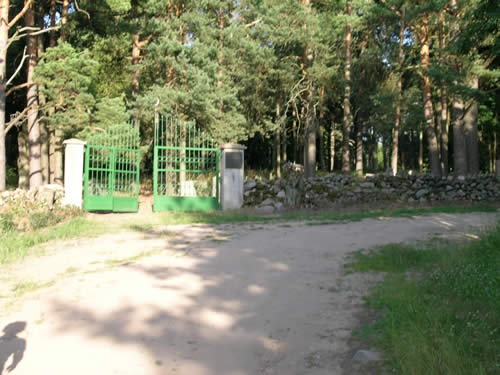
Image 2 Kruszyniany Muslim Cemetery
Kruszyniany is home to one of three active Tatar mosques in Poland. Its mosque
and nearby cemetery were established in 1679. The cemetery can be reached by
exiting the side gate of the mosque grounds, and following a dirt road that winds
upwards towards the cemetery set in the pine forest. Much to our surprise when we
arrived at the cemetery a tour was underway. Not wanting to interrupt, we looked
about on our own. What immediately caught my eye on many of the tombstones
was the symbol of Islam: the crescent moon with five stars – the crescent moon to
remember the beginning of the month of Ramadan when Muhammad received his
first revelation from Allah; the five stars for the Five Pillars of Islam. Yet many of
Kruszyniany’s tombstones did not have five stars but six or seven and the crescent
was angled in a variety of positions! Perhaps Poland’s Muslim Tatars had one or two
additional ‘pillars’? (Image 3)
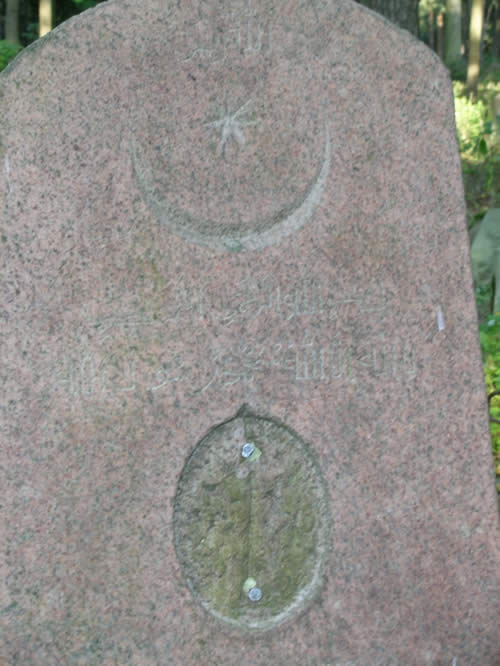
Image 3 Crescent Moon with Six Stars
As the tour and its guide began leaving the cemetery, the guide greeted us in
Russian with Dobry Djein (“Good day”), rather than the Polish Djein
Dobry – a reminder of Kruszyniany's proximity to the Polish-Belarusian border.
He inquired if we were “Polish” to which we replied “Nie (No). American. Do you
speak English?” His response, “Nie problema” (Russian) “No problem”. How
wonderful! I would learn the mystery of the ‘six or seven stars’ of Kruszyniany in
English! We followed him back to the mosque where he first promptly explained to
us every exquisite detail of his mosque … in French! … after which we returned to
the Tatar Muslim Cemetery of Kruszyniany.
In the cemetery, our tour began in the earliest section dating to 1679; our host
explained how the first Tatar came to this region and married a Polish woman. By
‘evolution’ thereafter the children became Muslims. He delineated how families
would be buried together: first came pere ‘father’ (the largest grave and
monument), then mere ‘mother’, then bebe ‘baby’ children,
respectively. All who were buried in this cemetery had belonged to this Tatar
community in Poland.
He moved us through the cemetery in what seemed to be a very non-systematic
way, following the pattern of burial as the cemetery grew year by year. Monuments
progressed from the simplest burial with engraved boulders until the most recent
burial in 1992 with its tombstone of fine polished granite. Our Tatar guide pointed
out significant details on the tombstones. In keeping with Islam’s proscription
against iconography, no images were allowed save a symbol that a man had served
in the military, the traditional Muslim symbol of the crescent moon and five-pointed
stars, Qur’anic verses, or the name of Allah in an exquisite calligraphic hand that to
the unknowing eye would have been perceived of as a type of ornate decoration. At
this point, I managed to squeeze in my question as he was guiding us back toward
the entrance gate.
Nearby stood those same tombstones where earlier I had seen the six or seven
pointed ‘stars’ cradled in a crescent moon. I counted the stars – “un, deux, trois,
quatre, cinq, six, sept …., non cinq? Pourquai?” Without hesitation he responded:
“Catholique.” The Catholic artisans did not realize the significance of the five stars
and crescent moon. They thought the symbol was merely decorative. The more
recent monuments of highly polished black or gray granite did indeed resemble
those found in Catholic cemeteries in Poland. Only the names in both Arabic and
Polish, and the ‘symbols’ betrayed the distinction in religions. That the monuments
where engraved and built by Catholic Poles, perhaps since the cemeteries inception,
belied at least an ongoing relationship between Tatar Muslims and Polish Catholics.
Yet the earliest boulder-style tombstones stood unique in this Tatar cemetery,
reminiscent of those also found in Jewish cemeteries in this region (Image 4)
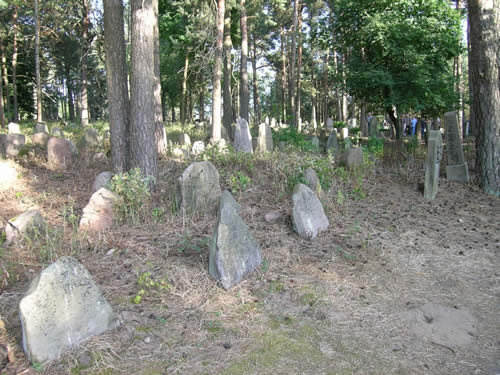
Image 4 Boulder Tombstones at Kruszyniany Cemetery
As to Jewish tombstone engraving, precise documentation as to whose hand
engraved the Jewish tombstone is generally lacking, excluding the elaborate
monuments found, for example, in the Jewish cemetery in Warsaw.
In the small shtetl cemetery of Drohiczyn, south of Bialystok, the roughly
chiseled boulder-style stones bear what appears to be the handiwork of three
artisans (Image 5). Perhaps these three artisans, whose work spans sequential
decades, derive from the same family of Jewish artisans. The passing of such
artisanship within Jewish communities or regions is not unknown as Monika
Krajewska described in her work Tribe of Stones.
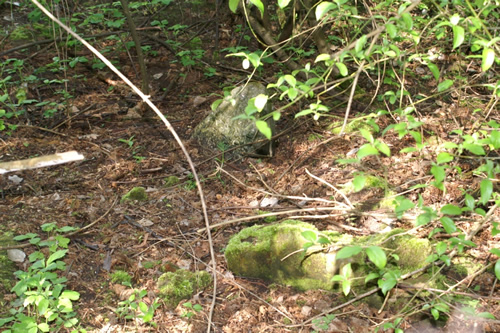
Image 5 Boulder-style matzevah at Drohiczyn,
Poland
Another hint at the identity of the artisan of Jewish tombstones is inadvertently
offered in Yekhile Shtern’s “A Kheyder in Tyszowce (Tishevitz).” Shtern
writes:
There were two doors from the hall [of the kheyder], one on the west to the
right and the other east off to the left. On the right there was only the opening for a
door, which led to the ruins of a house, four walls minus a roof, joined by two of its
walls to the west wall of the kheyder. This was an unfinished house in which were
stored stone and wooden tombstones. The teacher’s son was a tomb-stone engraver
and he would do his work here. The place was full of youngsters who would follow
the work of the engraver with curiosity and then try to imitate him by drawing with
chalk on the walls either hands in the position of the priestly benediction or other
figures found on tomb-stones. When the engraver was not present the boys would
practice climbing on the stones.
The proximity of the tomb-stones to the kheyder gave rise to fantastic
tales about ghosts and migrating souls. No one dared venture into the ruins at
night. During the winter we had classes at night and we were afraid to go through
the hall because of the tomb-stones. The reflection through the door of a white and
snow-covered stone seemed certain to be a ghost in shrouds. The teacher, therefore,
would lead the children out through the hall.
While Shtern’s recollection clearly indicates that the tombstone engraver of
Tishevitz, a shtetl near Lublin, Poland, was Jewish and the son of the
kheyder teacher, thus knowledgeable in Torah and Talmudic study as well as
trained in calligraphy, such precise information is not extant as to who engraved the
tombstones in Bagnowka Beth-Olam. However, hints offered by engraving
techniques and supposed errors suggest that the tombstone artisans were Jewish or
working in collaboration with Christian artisans – at least in the first decades of this
cemetery’s use (1892 - c.1920).
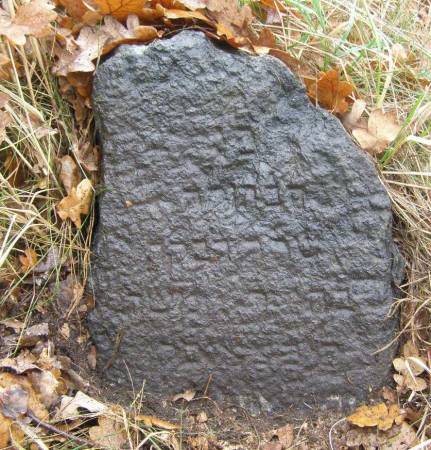
Image 6 Tombstone of “the unmarried Sarah Rivkeh daughter
of R. Mosze”
In Bagnowka Beth-Olam, over a dozen boulder-styled or roughly hewn
granite matzevoth are among the oldest tombstones in this cemetery. Their
inscriptions are carved or etched into the stone. For example, in the inscription of
Sarah Rivkeh the same letters lack uniformity in execution. The letter Resh
/r/ in Sarah’s inscription clearly represents the same consonantal sound but the
strokes needed to fashion each Resh are not of the same size or depth (Image
6).
Such details suggest a crude execution by hand rather than the smooth
uniformity created using a template or later by sandblasting, employed by the late
19th century. In addition, less than ten matzevoth exhibit a
slight smoothing of the inscriptional surface though engraving is once again by
carving the letters into this surface, with the letters again demonstrating unevenness
in execution. It is not simply that the letters are not uniform – for letters on Hebrew
scrolls, mezuzoth, manuscripts, and even synagogue inscriptions will be
elongated or narrowed in order to create right and left justified margins. Rather in
the case of these matzevoth the lack of uniformity for the same letters,
combined with a crude execution, suggests these inscriptions were fashioned by
hand.
Similar matzevoth are found in such small shtetl cemeteries as
Drohiczyn and Narew, south of Bialystok. However, there are other engraving
details that suggest a Jewish artisan at work on some of the matzevoth from
Bagnowka Beth-Olam.
According to Jewish tradition, before a sofer (scribe), writes each word,
letter by letter, upon what will be a new Torah or festal scroll, horizontal lines are
lightly marked into the prepared leather or parchment. Each letter will be ‘hung’
from this line, at times extending above the line for certain letters. These lines assist
in creating an illusion of perfectly executed horizontal lines of texts, one after
another.
On one tombstone from Bagnowka Beth-Olam such horizontal lines are
still visible, reminiscent of the Jewish tradition of marking scrolls (Image 7).
However, for each line of text, rather than just one line etched into the sandstone,
four equidistant lines are present. The letters are thus more properly located
between these top and bottom lines, rather than hung from the line as in the writing
of a scroll. Again the letters are not uniformly executed (as in the earlier boulder
and rough hewn matzevoth), suggesting this matzevah may have
been chiseled into the sandstone by a Jewish stonecutter, who failed to brush away
these guide lines.
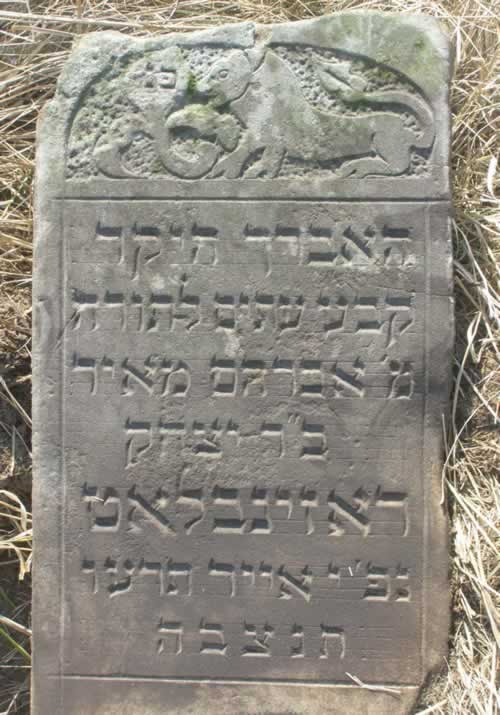
Image 7 Horizontal engraving lines on the matzevah of
“the young scholar who set aside times for the Torah, the late Abraham Meir son of
R. Icchok Rozenblat. He died 10th Iyar 5676 [13 May 1916]. May his
soul be bound in the bond of everlasting life.”
Another epigraphic element that suggests a Jewish engraver is the use of
truncated or shortened words, a practice that allows a word to be shortened in order
to adapt the word to the size of the inscriptional field. Such truncation frequently
involves removing the letter Heh /h/ at the end of the word. Sometimes its removal
is indicated by a dot over the Heh, an apostrophe-like symbol (׳) or no marking at all. Such truncation occurs with
the proper names Jeremiah (ירמיה), Zechariah (זכריה), and
Arieh אריה)).
More intriguing is the dropping of the final Heh in the feminine adjectives
‘important’ (חשובה) and ‘modest’ (צנועה). In one
inscription this feminine Heh ending on the word ‘the woman’(האשה) also serves as
the Heh that marks the definite article on the following feminine adjective
‘modest’, resulting in two conjoined words (האשהצנועה). In another inscription, the father’s name Dov Ber דוב בער is written דובער, writing one Beth (ב) instead of two (Image 8).
The ability to accurately shorten these names and words requires a linguistic
familiarity with the Hebrew language or at least close collaboration between the
Christian artisan and the Jewish epitaph composer. Michael Nosonovsky’s research
on Jewish epitaphs in the Ukraine has revealed these same linguistic phenomena
dating to as early as the 17th century, suggesting such practice may
have been part of traditional Ashkenazic tombstone engraving.
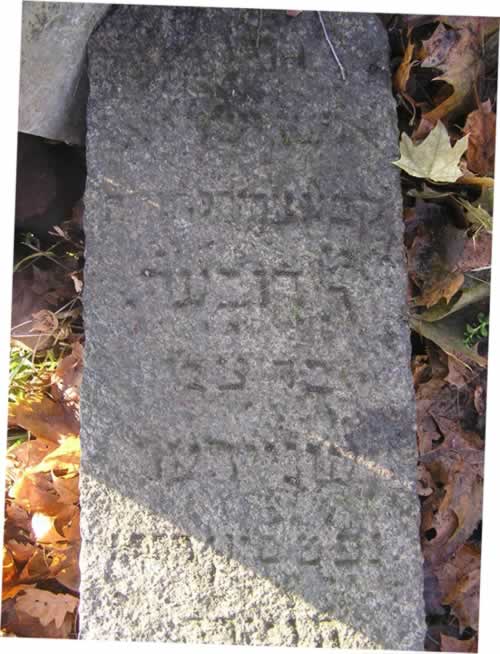
Image 8 Epitaph of “R. Dov Ber son of R. Zwi Sznajder”
Lack of collaboration between the Christian stonecutter and the Jewish composer
of an epitaph, however, may explain the presence of other types of errors in the
inscriptional field. So, for example, we find orthographic confusion with the very
similar Hebrew letters Dalet ( ד ) and Resh ( ר ) in the representation of the year of death. On one
occasion the four letters used to represent the Hebrew year of death are oddly
subdivided. In another epitaph the surname Mendelson is divided over two lines as
“Mendel / son” (Image 9). In both cases, this unusual division serves to
accommodate the size of the inscriptional field. Error in gender agreement is also
found. For example, in one inscription for a woman the text then references
“his date of birth.”
In yet another inscription, the common opening abbreviation Peh"Nun “Here is
buried” has been fully written out, merging into the opening text. In doing so,
however, the composer or engraver failed to write the feminine verb form for the
deceased who was a woman. In another inscription, the epithet ‘ha-lewi’ “the Levite”
was initially omitted and later added in smaller letters below the surname.
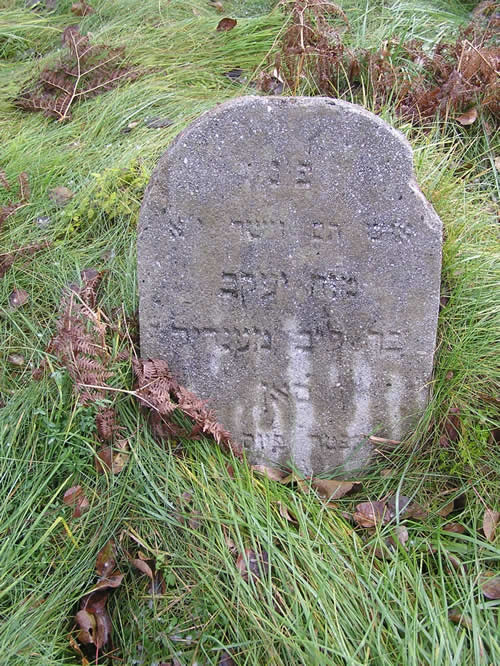
Image 9 Epitaph of “Jakob son of Lejb Mendel / son”
In yet another inscription the stonecutter failed to complete the year of death,
providing only the Tav which represents 400 years. In all but a few epigraphs at
Bagnowka Beth-Olam the thousand marker, the Heh (= 5000), is not written.
An abbreviation meaning “as the abbreviated era” serves to clarify its absence. Yet in
the epitaph fragment for the son of Dov Polok, the date of death is written “he died
13 Tevet [5]4” followed by a vacat, a smooth blank space (Image 10).
Surrounding tombstones in this section suggest a date of 5693 (1933), which
would be written as תרעג. Why the remaining letters were
never written remains a mystery. In Christian tradition it is not uncommon for a
family to have a headstone partially engraved, with names and dates of birth for the
deceased provided. When a family member passes away the year of death is then
added. However, in Jewish tradition the tombstone is not erected until typically the
first yahrzeit “anniversary” of the deceased’s death at an unveiling ceremony.
Thus, at the first yahrzeit, recollection of year of death should still be
accurate. In the case of the son of Dov Polok’s epitaph either the stonecutter
erroneously omitted the remainder of the year of death or for some financial reason
the tombstone was erected a number of years after the deceased’s passing and thus
the precise year of death was unknown.
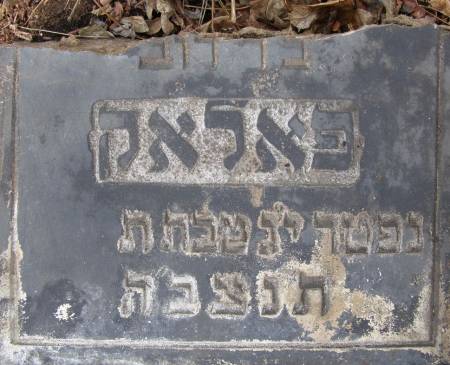
Image 10 Vacat on epitaph of “son of Dov Polok. He died 13 Tevet [5]4.
May his soul be bound in the bond of everlasting life.”
In her book, A Tribe of Stones, Monika Krajewska, views the nature of
errors in Jewish epitaphs as evidence that only Jews could have carved these stones.
The examples provided here from Bagnowka Beth-Olam add support to
Krajewska’s assertion. The sharing of select monument styles with the Christian
community – such as a tree with broken branches for those who perished before
their time (and a story for another time), suggests collaboration with the Christian
tombstone artisan.
However, the very scribal errors I have described – haplography, truncated
words, transposition and confusion of similar shaped letters are all well-documented
scribal errors in the transmission of the Hebrew Bible. The scribes of the Hebrew
Bible tradition - the Masoretes, literally counted each and every letter in each and
every book of the Hebrew Bible, noting how many words, verses, and sections
existed in each book, what the middle word of each book was, and where and how
often parallel phrases occurred in biblical books. Even these scribes, as well as the
scribal schools that followed, fell prey to scribal errors, a result of the imperfection
between the human eye and the hand bringing words to parchment.
While my guide at Kruszyniany matter-of-factly explained that the source of
errors on the Tatar tombstones derived from the hand of the Christian tombstone
artisan, the errors in Bagnowka Beth-Olam more readily suggest that at
Bagnowka Beth-Olam the tombstone engravers (at least ) in the early decades
were Jewish. Later Jewish tombstones at Bagnowka Beth-Olam sharing the
same monument style, crafted by sandblasting, and offering simplicity in
biographical information as on Christian tombstones, may very well owe their
provenance to a Christian stonecutter.
In recognizing the hand of the Jewish tombstone engraver at Bagnowka Beth
Olam in these early tombstones, especially the boulder-style ones, I can’t help
but wonder, too, who might have carved the boulder-style tombstones in the Tatar
Muslim cemetery in Kruszyniany. In contemplating errors in funerary artisanship, I
also can’t help but ponder on the dynamics of inter-religious dialogue amongst
Jews, Christians and Muslims in the late 19th to early 20th
century in current northeastern Poland.
Photo Credits: Heidi M. Szpek and Frank J. Idzikowski
Sources
Monika Krajewska, A Tribe of Stones: Jewish Cemeteries in Poland. Warsaw,
1993.
Michael Nosonovsky, Hebrew Inscriptions from Ukraine and Former Soviet
Union. Washington D.C., 2006.
Yekhile Shtern’s “A Kheyder in Tyszowce.” In East European Jews in Two
Worlds: Studies from the YIVO Annual, edited by Deborah Dash Moore.
Northwestern University Press and YIVO Institute for Jewish Research, 1990: 51-
70.
Heidi M. Szpek, Ph.D. is Chair and Associate Professor in the Department of
Philosophy & Religious Studies at Central Washington University (Ellensburg,
Washington), currently writing a book on the Jewish epitaphs from Bialystok,
Poland. Her most recent journal articles on Jewish epitaphs include “Jewish Epitaphs
from Bialystok, 1905-6: Mending the Torn Thread of Memory.” East European Jewish
Affairs. Vol. 41, Nos. 1–2, April–August 2011, 1–23, and “Filial Piety in Jewish
Epitaphs.” The International Journal of the Humanities. Volume 8.4 (2010): 183-202.
She has also contributed a variety of articles on Jewish epitaphs and Jewish material
culture in northeastern Poland to The Jewish Magazine online. Her website is
www.cwu.edu/~szpekh
~~~~~~~
from the September 2011 Edition of the Jewish Magazine
|